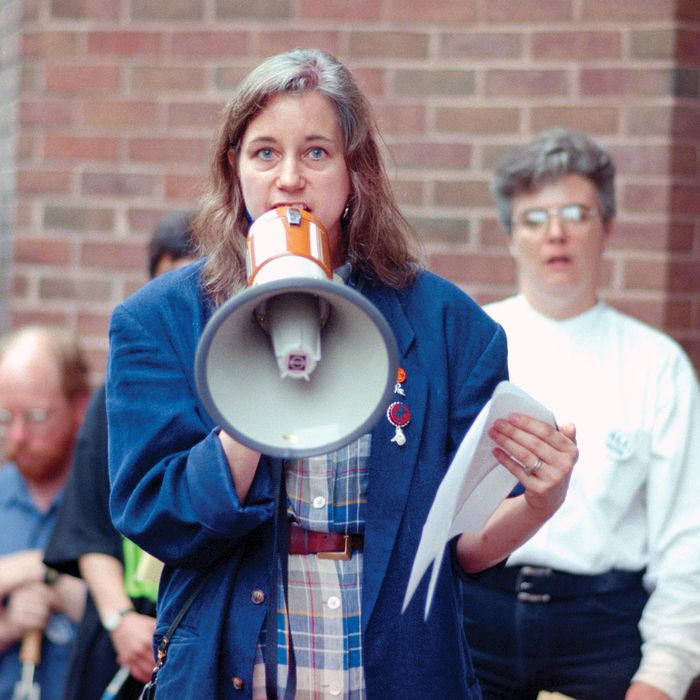
Baltimore is a city where they give directions according to what’s not there anymore,” Laura Lippman says, quoting an old newspaper colleague of hers named Linell Smith. Lippman ought to know because she, apart from several years away in her 20s, has spent her entire adulthood in town. She was a reporter for more than a decade at the Baltimore Sun, and in the past 22 years has set 23 crime novels and thrillers in and around the city. Her latest book, Lady in the Lake, takes place mostly downtown in the mid-’60s, and today she and I are headed out to find some places that used to be here.
Baltimore is layered with loss. It was a factory town with aspirations, one that was built to house nearly twice its current population with great civic imagery to match — the Beaux-Arts monuments and crab houses, Pimlico races and rowhouses with white marble steps. If you’re searching for Lost Baltimore, the city you find depends on the one you were thinking about beforehand. John Waters’s tacky-aluminum-TV-tray city is one, where the fringe people are the soul of the place. Barry Levinson’s ’60s diner doofuses, Ta-Nehisi Coates’s radical-black-intellectual father, Russell Baker’s down-and-out Depression-era white folks, Anne Tyler’s eccentric families — they all pass one another on the streets in the city of the mind. So do the people who live in Edgar Allan Poe’s Baltimore and H. L. Mencken’s and Brooks Robinson’s. (Linell Smith’s grandfather was Ogden Nash, who left and came back, later writing, “I could have loved New York had I not loved Balti-more.”) All those images float over the contemporary vision of the dysfunctional city indelibly laid down on The Wire, the HBO series created by David Simon — who happens to be Lippman’s husband. It aired a decade ago, but no matter how many Brooklynish farm-to-table food halls open, you can’t unsee it. Lippman made a wry joke on Twitter the other day about the dudes who approach her husband everywhere, saying that she may end up writing an essay called “Men Explain The Wire to Me.”
We start out south of the Inner Harbor, in the neighborhood where Lippman and her family live. It’s a low-scale area of brick rowhouses — vaguely like Carroll Gardens — and their house and nearby offices are handsome but pleasantly non-palatial. In their living room, I spot one bookshelf where Simon’s books sit a couple of feet away from a full set of Lippman’s novels and alongside the books written by her father, Theo Lippman Jr., who was a columnist at the Sun. She’s 60, which is mildly surprising partly because she gives off the vibe of someone a decade or so younger and partly because she has a 9-year-old daughter. (On Longreads earlier this year, she wrote movingly about the ups and downs of being an old mom.) Waters’s books are there too. “He married us,” Lippman notes. “He has an amazing track record — like 18 couples, and 17 are still together.”
Even before we head out, Lippman cautions against reveling in the multiple lost Baltimores we’re going to see. “I can’t be nostalgic for 1966,” she says, “because basically what you’re saying is Wasn’t Baltimore great when it was white?” The city was explicitly segregated well into the ’60s with whites-only amusement parks and brutal redlining. Swaths of the city thinned out during the years of job loss, and many blocks are near-ruins, but Mulberry Street, where we pause on our tour, is in the midtown core, well kept and pretty. “That’s where Maddie lives,” Lippman says as we turn onto Cathedral Street.
At the start of Lady in the Lake, Maddie Morgenstern Schwartz is living in Pikesville, the city’s main Jewish inner-ring suburb. She’s 37, in a comfortable but dull marriage that has produced a crabby teenage son, and at the start of the book she bolts. She cashes out her engagement ring, rents that apartment at Mulberry and Cathedral, has a mostly-for-the-sex fling with a cop — who is black, so their hookups have to be discreet — and happens upon a corpse. Maddie proceeds to some amateur sleuthing and door knocking and leverages her findings into a job at the Baltimore Star, a second-tier daily. She doesn’t really know how to report a story, but she plunges ahead — “so ambitious and so focused on a goal that [she] can miss so much,” Lippman says to me.
Lippman’s books fall into two groups. A dozen are a continuing series starring the private eye Tess Monaghan. The rest are one-offs, and they are arguably a little more writerly and experimental. (We will not be using that tiresome “transcends genre fiction” line here. Good books are good books.) Last year’s Sunburn, for example, starts out as a shore-town just-passing-through femme-fatale encounter and then gets complicated. “My agent and I met yesterday, and we were talking about the fact that not a lot of crime writers, especially U.S. crime writers, are being paid well to write whatever book they want to write — they’re not being urged to do the same kind of book over and over again. And to have that freedom to go from Sunburn to Lady in the Lake …” she says, trailing off gratefully.
The Star’s people are vivid and central in the new book. That world of cynical reporters and editors is one Lippman knows extremely well from her years at the Evening Sun, a looser afternoon sibling to the morning paper. (Old Baltimoreans still refer to “the Sunpapers,” one word.) She took a stab at TV, too, co-hosting a CBS travelogue series called Going Places when she was all of 20. Lippman wrote her first seven novels while on the paper and met her husband there, too, although they didn’t get together till later. Ask her about her reporting jobs, and anecdotes about the texture and culture of newsrooms flow easily. “It was so loud! And people still smoked. I literally had one of my editors, a woman sitting close to me, burn a hole in my dress one day.” Rob Hiaasen, her close pal from the Sun features desk, was murdered at the Capital Gazette last year, and talking about him causes her voice to crack. In an afterword to the new book, she writes, “I had no idea that it was going to become a newspaper novel,” but it seems to have been nearly inevitable. And I can tell pretty quickly why Lippman was a good reporter: She is an appealing person to talk to, upbeat and bubbly but not in a trying-too-hard way.
We pull up into the Village at Cross Keys, a 1960s open-air shopping mall, once chic and now a little dated but still pleasant. There’s a shop here called the Store Ltd. that’s a beaut — a design store, full of Marimekko and Alessi, that opened in 1965. Its co-founder Betty Cooke, a jewelry designer who’s 95, still sells her work here. In the book, Maddie admires Cooke’s jewelry but can’t quite swing the investment. Lippman owns a little bit of it — she’s giving one piece away in a book-promotion contest — and she says, “I finally gave my mother some a couple of years ago.” Was her mother, who is just about Maddie’s age, a model for the character? Lippman seems startled when I ask. “It’s fair enough — she’d be a teeny bit younger, but I hadn’t really thought about that! And — no. But I did give her my mother’s name, Madeleine, and my middle name.” She pauses, then comes back to the idea. “You really don’t want to think about your mother’s sex life, though.”
We drive on, passing the Cylburn Arboretum, where that body turns up. Lippman says she prowled the grounds, figuring out where Maddie would have encountered a body that had lain undiscovered for a few days. She also immersed herself in the pop culture of the era — old ads, TV shows — as well as news coverage of a pair of real-life Baltimore murders from the late ’60s, details of which infuse Lady in the Lake.
The book also incorporates inventive shifts in point of view. There about 15 or so sidebars where a minor character gets to break out for a few pages of monologue: A news reporter enumerates his late-career anxieties; a pioneering female cop recaps her career; Paul Blair, the Orioles’ (nonfictional) center-fielder, narrates his at-bat as Maddie and her lover watch in Memorial Stadium. “Have you written anything this way before?” I ask Lippman, and she rolls her eyes and smiles, saying, “Has anyone?”
But it suits Baltimore, a fractured place where cars and buildings burned once more in 2015 after Freddie Gray was mortally injured in the back of a police wagon and the cops were acquitted. In the past decade alone, two mayors have quit owing to cheesy scandals. (One had misappropriated gift cards; the other was self-dealing in bulk purchases of her Healthy Holly children’s books. In her honor, Lippman’s pub-trivia team is called Healthy Holly LLC.) Harborplace, the waterfront mall that was the focus of the ’80s downtown renaissance, went into receivership last month. “And we have a Republican governor, Larry Hogan, incredibly anti-Baltimore,” Lippman adds, noting that the city proper is one of only three or four reliably blue counties in Maryland, the ones that usually carry the state. Even amid all that, the .01 percent are in evidence. Over in a development called Harbor East, “the penthouse on the top floor of the Four Seasons is on the market for $12.5 million,” Lippman says, nearly incredulous, suggesting that buying it “would obviously be some sort of tax dodge.” Or maybe cover for something darker, something for Maddie and her editors to look into.
*This article appears in the July 8, 2019, issue of New York Magazine. Subscribe Now!


